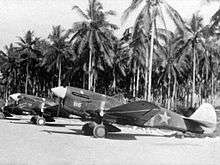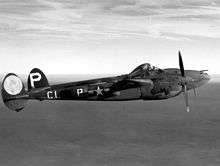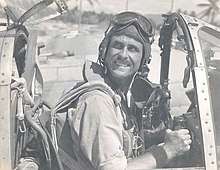Robert B. Westbrook (pilot)
Robert Burdette Westbrook (9 November 1917 – 22 November 1944) was a United States Army Air Forces lieutenant colonel and a World War II flying ace. Westbrook commanded the 44th Fighter Squadron, and became the leading fighter ace of the Thirteenth Air Force. He is also the ninth ranking fighter ace in the Pacific during World War II and also one of ten United States Army Air Forces pilots who became an ace in two different types of fighter aircraft.[1]
Robert B. Westbrook | |
|---|---|
 | |
| Nickname(s) | Bob Westy |
| Born | November 9, 1917 Los Angeles, California |
| Died | 22 November 1944 (aged 27) off Makassar, Japanese-occupied Dutch East Indies |
| Allegiance | United States |
| Service/ | California National Guard United States Army Air Forces |
| Years of service | 1936–1944 |
| Rank | Lieutenant Colonel |
| Unit | 18th Fighter Group 347th Fighter Group |
| Commands held | 44th Fighter Squadron |
| Battles/wars | World War II |
| Awards | Distinguished Service Cross Silver Star (2) Distinguished Flying Cross (2) Air Medal (16) |
Early life
Westbrook was born in Los Angeles on 9 November 1917, and attended Hollywood High School, where he joined the ROTC and became a cadet captain. After graduating in 1935, Westbrook studied at the University of California, Los Angeles for a year. He became a member of the California National Guard and was federalized along with his unit in March 1941.[2]
Military career
Westbrook applied for United States Army Air Corps flight training later that year and was accepted. He was awarded his wings with Class 42-G at Luke Field, Arizona, on July 26, 1942, and then ordered to Hawaii. On August 15, he joined the 44th Fighter Squadron of the 18th Fighter Group. which was equipped with the Curtiss P-40 Warhawk, at Bellows Field on Oahu.[3]
World War II

Westbrook was promoted to first lieutenant in October, and on October 20, the 44th FS pilots and ground crews were transported to New Caledonia. Shortly thereafter, the squadron's P-40s arrived at the port of Espiritu Santo. When the planes were operational, the pilots flew them from Espiritu to their new base on the nearby island of Efate.[4]
The 44th FS became part of the 13th Air Force when it was activated on January 13, 1943. A week later, its pilots flew their planes to Guadalcanal in the Solomon Islands, from which they began flying combat missions. Westbrook scored his first kill on January 13, 1943, when he shot down an A6M Zero, during an intercept of an Imperial Japanese Navy Air Service raid on Guadalcanal consisting of nine Mitsubishi G4M “Betty” bombers escorted by 30 A6M “Zeros.” On February 14, while flying a bomber escort of B-24 Liberators, Westbrook shot down one enemy fighter, while other P-40 pilots shot down four and probably destroyed two others. Westbrook received his first Silver Star, for this mission. On April 14, the 44th FS was assigned at Guadalcanal with the 18th Fighter Group. Westbrook was promoted to to captain in early May.[5]

On June 12, Westbrook shot down a Zero near near the Russell Islands, northwest of Guadalcanal. This was his fifth aerial victory and this made him the first flying ace of the 44 FS. He scored his final aerial victories in the P-40, when he shot down a Nakajima A6M2-N "Hap" and a Zero, while protecting Allied ships that were supporting the landings on the island of New Georgia and nearby Rendova Island. On September 25, 1943, Westbrook was promoted to major and became commander of the 44th Fighter Squadron. The 44th FS transitioned from the P-40 to Lockheed P-38 Lightning. Westbrook flew his first combat mission in the P-38 on October 10 and scored the 44th's first P-38 victory on a mission with the 339th Fighter Squadron. On that day, while flying a bomber escort, he shot down one enemy airplane and shared destruction with another. On September 1943, Westbrook was promoted to major and became commander of the 44th Fighter Squadron.[6]
During December 1943, he shot down six Japanese planes in a three day span over Rabaul. He received the Distinguished Service Cross, for his aerial victories in a three day span. On January 6, 1944, during a fighter sweep over Rabaul, Westbrook was credited with a shared destruction and a probable enemy aircraft destroyed. It was his last mission with the 44th FS. After scoring his fourteenth victory, Westbrook was sent back to the continental United States on leave in spring 1944.[7]

Westbrook returned to Guadalcanal and, in May, was appointed Deputy Commanding Officer of the 347th Fighter Group and promoted to lieutenant colonel. The 347th was then based on Stirling Island, but it moved to Sansapor, in Western Papua, in August and then to nearby Middleburg Island in September. He was appointed as aide to the commander of the Thirteenth Air Force.[8]
On these missions from June, Westbrook shot down five Nakajima Ki-43 “Oscars.” They included one near the airfield at Kendari, Dutch East Indies on September 25 and another five days later near an aerodrome in Boroboro, Southeast Sulawesi. On October 23, he was credited with three of them over the Boeloedowang Aerodrome near Makassar. These were his last aerial victories of the war. The 347th FG was awarded a Presidential Unit Citation for three missions in November.
During World War II, Westbrook flew a total of 367 combat missions. He was credited with the destruction of 20 enemy aircraft in aerial combat, which includes 13 in P-38 Lightning and 7 in P-40 Warhawk. With 20 victories, Westbrook became the Thirteenth Air Force's highest scoring ace.[9]
Death
On November 22, 1944, on his final mission, Westbrook was leading the flight to destroy the Japanese naval convoys at the Bay of Makassar. The flight proceeded to destroy or heavily damage 13 vessels by strafing. While strafing a Japanese gunboat, his P-38 was hit by anti-aircraft fire from the convoy. He leveled his P-38 in an attempt to make a water landing, but the P-38 turned its nose down and slammed into the water, killing him instantly. Two other P-38s were also shot down on the same mission. [10][11]
Westbrook's remains were never recovered.[12]
Awards and Decorations
His decorations include:
 | ||
| USAAF Pilot Badge | ||
| Distinguished Service Cross | Silver Star w/ 1 bronze oak leaf cluster |
Distinguished Flying Cross w/ 1 bronze oak leaf cluster |
| Purple Heart | Air Medal w/ 3 silver oak leaf clusters |
American Defense Service Medal |
| American Campaign Medal | Asiatic-Pacific Campaign Medal w/ 3 bronze campaign stars |
World War II Victory Medal |
| Army Presidential Unit Citation | ||
Distinguished Service Cross citation

- Westbrook, Robert B.
- Major (Air Corps), U.S. Army Air Forces
- 44th Fighter Squadron, 18th Fighter Group, 13th Air Force
- Date of Action: December 23, 1943 – December 25, 1943
- Citation:
The President of the United States takes pleasure in presenting the Distinguished Service Cross to Robert B. Westbrook, Major (Air Corps), U.S. Army Air Forces, for extraordinary heroism in connection with military operations against an armed enemy while serving as Pilot of a P-38 Fighter Airplane in the 44th Fighter Squadron, 18th Fighter Group, 13th Air Force, in aerial combat against enemy forces on 23, 24, and 25 December 1943, in the Southwest Pacific Area of Operations. On 23 December Major Westbrook shot down one enemy aircraft. On 24 December Major Westbrook shot down three enemy airplanes in a single engagement, and on 25 December he shot down two more. Major Westbrook's unquestionable valor in aerial combat is in keeping with the highest traditions of the military service and reflects great credit upon himself, the 13th Air Force, and the United States Army Air Forces.[13]
Aerial victory credits
The data in the following table is from Newton and Senning (1978).[14]
| Date | Credits |
|---|---|
| 27 January 1943 | 1 |
| 13 February 1943 | 1 |
| 7 June 1943 | 2 |
| 12 June 1943 | 1 |
| 1 July 1943 | 2 |
| 10 October 1943 | 1 |
| 23 December 1943 | 1 |
| 24 December 1943 | 3 |
| 25 December 1943 | 2 |
| 6 January 1944 | 1 |
| 25 September 1944 | 1 |
| 30 September 1944 | 1 |
| 23 October 1944 | 3 |
Legacy
Westbrook is listed on the Walls of the Missing at Manila American Cemetery. There is a cenotaph placed for him at San Fernando Cemetery III in San Antonio, Texas.[15]
A street in Kadena Air Base is named for Westbrook.[16]
See also
- Richard Bong
- Gerald R. Johnson
- Thomas B. McGuire
- Charles H. MacDonald
- List of World War II air aces
References
Notes
- "Westbrook, Robert Burdett, Lt Col". togetherweserved.com. Retrieved 2020-06-19.
- Starke 1985, p. 144.
- Blake, Steve (1 August 2018). "Quadruple PTO Ace—KIA". pressreader.com. Retrieved 2020-06-19.
- "Lt. Col. Robert B. Westbrook". pacificwrecks.com. Pacific Wrecks. Retrieved 2020-06-19.
- Blake, Steve (1 August 2018). "Quadruple PTO Ace—KIA". pressreader.com. Retrieved 2020-06-19.
- Molesworth 2003, p. 69.
- Blake, Steve (1 August 2018). "Quadruple PTO Ace—KIA". pressreader.com. Retrieved 2020-06-19.
- "Lt. Col. Robert B. Westbrook". pacificwrecks.com. Pacific Wrecks. Retrieved 2020-06-19.
- Blake, Steve (1 August 2018). "Quadruple PTO Ace—KIA". pressreader.com. Retrieved 2020-06-19.
- Sherman, Stephen (20 April 2012). "P-38 Lightning PTO Aces of World War Two". acepilots.com. Retrieved 2016-11-27.
- "Westbrook, Famed Pacific Fighter Pilot, Shot Down". San Bernardino County Sun. 19 December 1944. Retrieved 31 May 2019.
- "Westbrook, Robert Burdett, Lt Col". togetherweserved.com. Retrieved 2020-06-19.
- "Valor awards for Robert Burdette Westbrook". Valor.militarytimes.com. Retrieved 2020-06-19.
- Newton & Senning 1978.
- "Robert Burdett "Westy" Westbrook, Jr". findagrave.com. Find A Grave. Retrieved 2020-06-19.
- "Kadena Air Base Street Names". Kadena Air Base. Retrieved 27 November 2016.
Sources
- Molesworth, Carl (2003). P-40 Warhawk Aces of the Pacific. Oxford: Osprey. ISBN 978-1-84176-536-5.CS1 maint: ref=harv (link)
- Starke, William H. (1985). Vampire Squadron: A History of the 44th Fighter Squadron in World War II, 1941-1945. Anaheim, California: Robinson Typographics. ISBN 978-0918837028.CS1 maint: ref=harv (link)